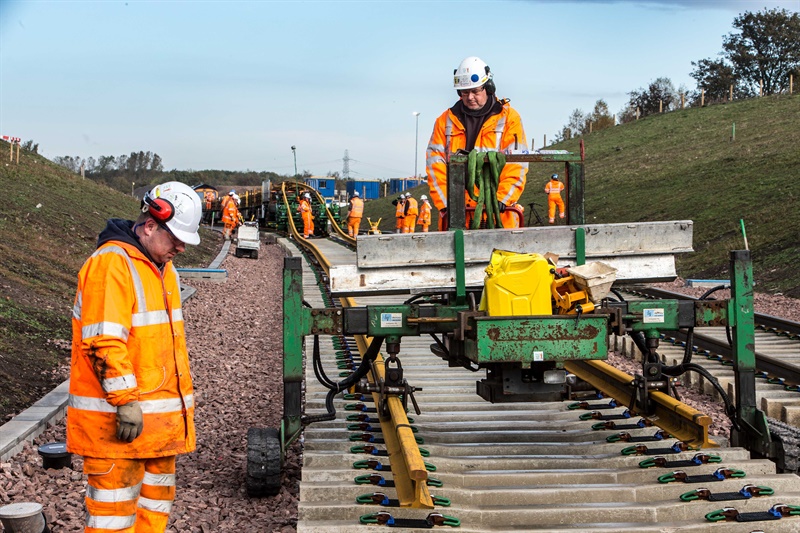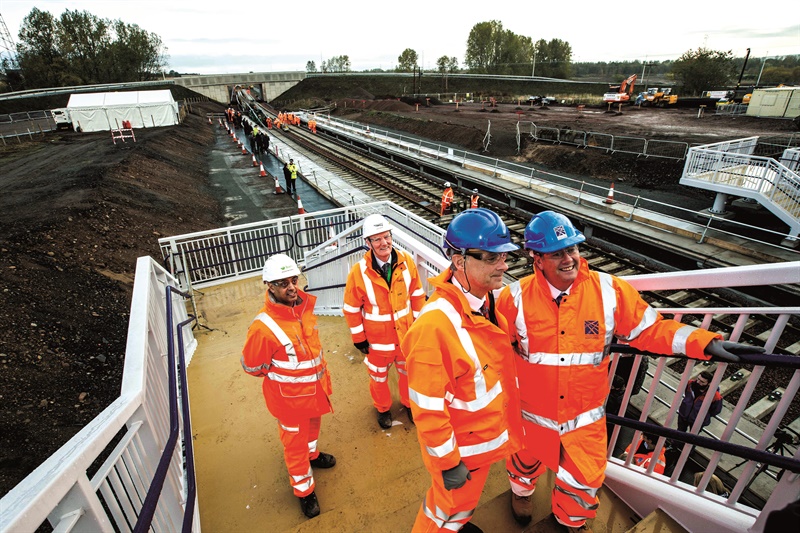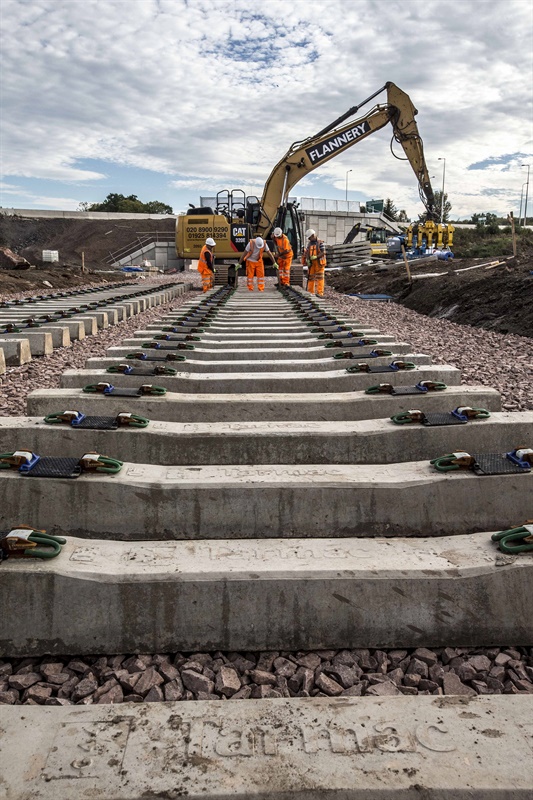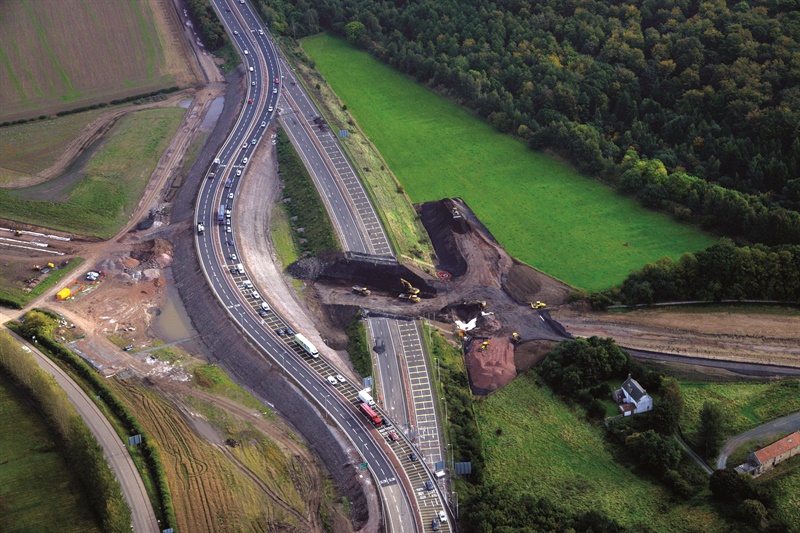01.11.14
1,300m of track a day on Borders Railway
Source: Rail Technology Magazine Oct/Nov 2014
On 6 October, track laying got underway on the £294m Borders Railway project – the longest new domestic railway to be constructed in Britain for over 100 years. RTM heard more from Nissar Mohammed, BAM Nuttall’s project director, and Niek Lentink, the project manager overseeing the rail systems installation.
Over the next few months, four engineering trains are on a constant cycle delivering lengths of rail from Scunthorpe to the Borders Railway project. Every train carries 24 rails of 108m length, allowing 1,300 linear metres of rail to be installed every day.
Project director for BAM Nuttall, Nissar Mohammed, told RTM: “The engineering trains are on a loop, so while one is on site working with our long rail unloading machine, there’s at least three other trains somewhere in the system, either getting loaded for the next day’s work, or on track and ready for the next morning’s production, or heading back to Scunthorpe to get laden again.”
Track laying began on 6 October – a date that the team had been working towards for two years. The earlier phases of the project were concentrated on large earthworks, ground stabilisation, structures, road alignment and rebuilding, the track formation and things like ecological protection and stakeholder management.

But now the team – just down from its peak of 1,000 workers – is using bespoke BAM plant to unload and install the rails. Laying all 50km of rail will require the offloading of 52 wagons, so will take until January.
Project manager Niek Lentink summarised that process: “The machine is basically three units in front of the Network Rail rail wagons. The machine pulls the rails off the wagon, holds them in front and drives them out, and drops them exactly in the fastenings of the sleepers. We clip up, drive the train over the work we’ve off-loaded, and we do the same again.”
With a normal shift being from 8am-6pm, and the offloading process taking about eight hours, there is also some extra “float” time every day for other aspects of the work.
Time pressures
Although the team does not have to work in a traditional possession, time pressures remain, Lentink told us. “We need to get the rail wagons back at certain times because of the train path back out to Scunthorpe. That means that every day there is still that same time pressure to ensure we get the trains offloaded and back in time for them to leave on time. As we work south towards Tweedbank, the pressure gets higher because the travel distance for the wagons gets higher.”
The offloading machine itself was developed by BAM Rail in the Netherlands, and this is the first time it has been used in the UK. It is particularly suited for working in narrow cross-sections – of which the Borders Railway has plenty.
BAM is working as the principal contractor to Network Rail, which was appointed by the Scottish government to deliver the scheme when the original procurement process fell through (in fact, BAM Nuttall was the only company left in the bidding when that process collapsed in autumn 2011).
Network Rail is using its internal supply chain to provide some rail materials and plant, for example, including ballast, sleepers, the rail engineering trains and tampers. In total, there are about 200 engineering trains on and off-site, Lentink said. Over 90,000 railway sleepers have been laid along the entire length of the route, which prompted Hugh Wark, project director at Network Rail, to say: “What has been a construction site for the last 18 months is starting to look like a railway.”
About 1,800 tonnes of ballast a day is being offloaded, with the tamping following afterwards. Most of the rail welding will then be via mobile flash butt welders. “We’re doing everything at the same time, which makes it a fantastic job to be on,” Lentink said.
The signalling, power and telecoms works have also started, progressively following behind the rail delivery aspects. There are six islands around which all the signalling equipment is based, linked to the location of the seven switches. Four of those have been installed, one was being finalised the day RTM spoke with Lentink and Mohammed, and there were two still to do.
The signalling and telecoms works over IP via a fibre route along the whole line forming the backbone of the communications. The lack of copper also cuts out a potential target for thieves, Mohammed said.
Although the new route is not electrified, it has been engineered to allow for easier OLE installation in the future.

(Above: The then Scottish transport minister Keith Brown MSP visiting the work site)
Seven new stations
Of the 50km route, 45km sits on the existing route along the Waverley Line that was closed back in 1969 – though the new project only reaches as far as Tweedbank, whilst the old line went all the way to Carlisle.
The Borders Railway line branches out after Newcraighall, with seven new stations to be built: Shawfair, Eskbank, Newtongrange, Gorebridge, Stow, Galashiels and Tweedbank.
Mohammed said that although the focus up to now has been to deliver the critical path – the track and rail systems corridor – construction has also started on the station platforms and car parks, with more and more focus on the stations as the go-live date draws closer. “That’s what the public will see developing over the next four to five months,” he told us.
Resources and workforce
Much has been written about the pressure on resources coming during CP5, with such a huge workbank. Mohammed said that had been addressed early on the Borders Railway with a strategy of looking across the entire Royal BAM Group for personnel and plant.
That focused particularly on BAM Nuttall in the UK, BAM Contractors in Ireland and BAM Rail in the Netherlands. “We also packaged up pieces of work that we might traditionally do ourselves to local sub-contractors,” he told us.

Everybody working on the project has been exposed to the company’s focus – and the of the wider project – on safety. BAM Nuttall’s approach to health and safety is known as ‘Beyond Zero’, a cultural focus on people being accountable for their own safety and that of their colleagues and the public, and refusing to ‘walk by’ if they see problems and to report them instead.
Mohammed said: “If they see anything that looks unsafe, they should deal with that there and then. There are key disciplines before we start work in the morning, such as ensuring nothing’s changed overnight, and that there has been no plant damage or vandalism for example. We also want to ensure we report everything, from a cut finger to anything more significant: that culture of reporting, training and being accountable is important.”
The importance of safety can also be seen in the decision to build expensive new road alignments rather than have level crossings. The A720 bypass, for example, had to be diverted when the rail corridor was constructed underneath it, before the road was put back on its original alignment over the top.

The safety and stakeholder management team, run jointly with Network Rail and Transport Scotland, has also been out in the community talking to schools, politicians, householders, local authorities and so on to keep people well informed, stress the safety messages, and deal with any complaints. The project team has also worked closely with British Transport Police.
Planning in advance
Two hidden factors that can disrupt even the largest projects are wildlife and utilities. In both cases, proactive work was done to ensure that when the construction arrived, it was not hindered or obstructed. Many animals have been given new habitats, and in the Victorian-era Bowshanks tunnel north of Galasheils, a series of one-way flaps and pipes were fitted to let Soprano pipistrelle and Myotis bats leave ahead of renovation works. Otters and badgers have also been found new homes, thanks to help from local authorities and Scottish Natural Heritage.
Working with the utilities companies was also necessary. Although the water, gas and power lines were generally well-charted, many diversions were necessary. “A lot of the utilities [companies] have struggled to align themselves with our programme,” Mohammed said. “In many cases we’ve had to work around their programmes to make sure we keep our ultimate milestone of commissioning maintained. We’ve been doing a lot of work to mitigate that.”
Construction is scheduled for completion in mid-2015, with services operated by new ScotRail franchisee Abellio beginning soon after.


(Above: Nissar Mohammed, BAM Nuttall’s project director, and Niek Lentink, the project manager overseeing the rail systems installation)
Tell us what you think – have your say below or email [email protected]